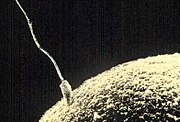his article is about biological sex. For alternate uses, such as sexual intercourse, see Sex (disambiguation).
In biology, sex is the process of combining and mixing genetic traits, often resulting in the specialization of organisms into male and female reproductive roles. Sexual reproduction involves combining specialized cells (called gametes) to form offspring that inherit traits from both parents. Gametes can be identical in form and function, but in many cases an asymmetry has evolved such that two types of gametes exist: male gametes are small and are optimized to transport their genetic information, while female gametes are large and carry the nutrients necessary for the development of the child organism.
An organism's sex is defined by the gametes it produces: males produce male gametes (sperm) while females produce female gametes (egg cells); organisms which produce both male and female gametes are hermaphrodites. Frequently physical differences are associated with the different sexes of an organism; these sexual dimorphisms can reflect the different reproductive pressures the sexes experience. In some cases female organisms also have the role of carrying offspring through the first part of development, a process called gestation.
Biological sex is distinct from gender. Although these words are commonly used interchangeably, gender refers to an individual's self-conception or social conception as being male or female.

No comments:
Post a Comment